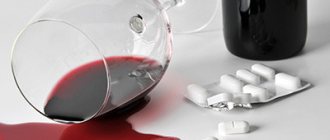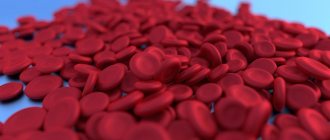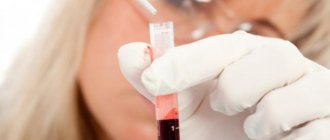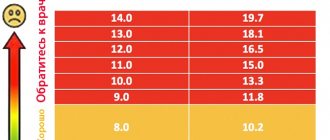The health and correct functioning of the cardiovascular and circulatory systems is a key condition for the normal functioning of the entire body as a whole, since their functions are to deliver nutrients and oxygen in the blood to all organs, tissues and systems of the body.
The ability of the circulatory system to supply the body with oxygen is diagnosed in accordance with the level of hemoglobin in the blood. A lack of hemoglobin is called “anaemia” - a condition that signals either a serious illness or an unhealthy lifestyle, including factors such as:
- unbalanced diet;
- insufficient water consumption;
- presence of stress and bad habits.
Factors of heredity and genetics also play a significant role.
studies have become widespread , according to which residents of France, Spain, Portugal, Italy, and Greece suffer less than others from problems with the cardiovascular and circulatory systems. According to the established assumption, a diet that includes the consumption of red wine contributes to maintaining the health of the heart, blood vessels and blood.
Other studies indicate that alcohol consumption is associated with a decrease in hemoglobin levels in the blood, which can contribute to the development of some serious diseases.
In this article we will discuss the effect of wine on the cardiovascular and circulatory systems in general, as well as on hemoglobin levels in particular.
Effect on the circulatory system
Wine consumption indeed affects the condition of the heart, blood vessels, blood flow and the process of hematopoiesis.
It is important, however, to meet certain conditions:
- give preference to dry red wine;
- consume responsibly - that is, in accordance with the instructions of specialists and within established standards;
- choose a quality product.
It is also advisable to consult with your attending physician, and in addition, take into account the factor of fermentation, which allows the body to remove and process alcohol.
Dry red wine in small quantities has a beneficial effect on the entire cardiovascular and circulatory systems. In particular, due to the systematic consumption of a glass of dry red wine, positive changes occur in the body.
Thus, scientists talk about the following beneficial effects of consumption:
- increased hemoglobin levels;
- improved blood circulation;
- stimulation of blood flow;
- preventing the development of atherosclerosis;
- blood thinning.
The increase in hemoglobin levels is due to the content in dry red wine of a certain set of microelements and nutrients involved in the synthesis of red blood cells, which also include hemoglobin. The natural nature of the effect makes it possible not only to increase hemoglobin when its level in the blood is low, but also to normalize its level if it is elevated.
Critical days are not for exploits!
It is especially important to monitor hemoglobin on critical days. Even during short periods, its level drops significantly. And during a period of prolonged blood loss associated with menstrual irregularities, it can reach a critical level. This is fraught with the development of anemia. Therefore, visiting a gynecologist is always the right decision.
Physical activity is not advisable at this time. Because the consumption of oxygen, which is already lacking in the body, increases.
Analysis, blood, test
Which variety should you prefer?
As for other wines, it is important to understand the following when consuming them.
- Dry red wine is the most preferred among all varieties. If you cannot drink dry wine, opt for semi-dry or semi-sweet wine.
- The white variety has a different effect on the body than the red variety. It has virtually no effect on the production of red blood cells, but has a positive effect on the digestive system.
- Sweet varieties , due to the large amount of sugar they contain, do not lose their benefits for blood formation, but they are largely devalued due to negative processes caused by the effects of sugar.
- Cahors, however, is considered one of the healthiest drinks for restoring and maintaining hemoglobin levels at a level sufficient for a healthy life. Doctors often prescribe 3-4 tablespoons of Cahors for those whose hemoglobin levels are critically low. Doctors recommend taking this traditional church drink with spoons, not glasses.
In addition to the beneficial effect on hemoglobin levels, Cahors has other beneficial effects for the body. Among them, the following deserve special mention:
- providing a general strengthening effect;
- prevention of colds;
- stimulation of the immune and digestive systems.
The consumption of Cahors, like the consumption of wine, should be approached responsibly, since containing a large amount of sugar can lead to additional problems. In addition, Cahors contains substances that can cause headaches. For this reason, it is not recommended to take Cahors at night.
Rules for drinking red wine for anemia
Red wine for anemia will help to quickly restore health with moderate consumption - no more than 1-1.5 glasses (100-150 ml) per day. Women should drink less than men; for them, the norm for pure alcohol is up to 20 ml. The stronger sex has a higher threshold - up to 30 ml of ethanol.
The drink should be on the table no more than 3-4 times a week. You should drink it slowly. And you definitely need to supplement it with healthy food, for example, boiled beef or veal. They go well with dry red wine and are themselves sources of iron. Other foods high in this substance should also be included in the diet.
Rules of consumption and daily allowance
It should be noted that countries that consume dry red wine on a daily basis are characterized by a special established consumption culture, which includes:
- limited consumption;
- pairing wine with healthy food;
- drinking wine in a calm mood and in pleasant company.
These rules also apply to the consumption of wine for medicinal purposes. To raise hemoglobin levels and keep them at an acceptable level, 1 glass (175 ml) per day is enough . During feasts, the norm can be increased to 2-3 glasses (350 - 475 ml).
Specialists
| 4.8 9 reviews | Belkina Tatyana Vilenovna Therapist 23 years of experience Doctor of the highest category Admission from 2100 rub. |
Moscow Clinic st. Polkovaya, 12, bldg. 1
Armedika on Leninsky Leninsky Prospekt, 123
| 4.8 38 reviews | Dvoretsky Leonid Ivanovich Therapist Experience 46 years Doctor of the highest category Admission from 3500 rub. |
| 4.5 9 reviews | Lobanova Tatyana Igorevna Therapist 7 years experience Admission from 2500 rub. |
Features of use during pregnancy
The beauty of dry red wine is that its consumption is not contraindicated during pregnancy.
Doctors allow consumption of up to a glass of wine per day throughout the entire period of pregnancy (preferably up to 100 ml and not daily).
It is recommended to dilute it with cool water and take it in small portions. This way it will be better and softer absorbed by the body.
During pregnancy, consultation with a doctor about the permissibility of drinking wine, including to raise hemoglobin levels, is a must!
Donate blood for testing twice a year
Medicine has not yet come up with another way to determine iron deficiency in the blood, other than the usual blood test. It just allows the doctor to judge the ratio of blood cells. But in order for the presentation to be complete, it is necessary to undergo this procedure at least twice a year. Given the stressful nature of our lives, such frequency will allow us not to miss the onset of the disease.
Iron deficiency anemia | Treatment | Symptoms – Doctor Myasnikov
Editor: Olga Alekseeva, Curator: Tatyana Belkina, Leonid Dvoretsky, Tatyana Lobanova
Themes
What else should you include in your diet?
To raise and maintain hemoglobin levels, the diet must contain certain groups of foods, the benefits of which are not limited solely to the correction of hemoglobin levels, but also lead to other positive changes in the body. Among the products you should give preference to:
- fresh seasonal fruits - especially pomegranates, since pomegranate is the record holder for the amount of substances beneficial to the heart and circulatory system; bananas, citrus fruits, pineapples, peaches, apricots, red grapes, apples, plums, etc. are also useful;
- berries: lingonberries, cranberries, chokeberries (chokeberries), currants, blueberries, blueberries and strawberries;
- fresh herbs - lettuce, coriander, parsley;
- vegetables - first of all, this applies to beets, since, according to research, the effect of beet juice on the cardiovascular and circulatory systems is comparable and superior to the principle of action of leading medical developments;
- red lean meat;
- fish - first of all, preference should be given to wild salmon (sockeye salmon, chum salmon, pink salmon, coho salmon, chinook salmon), although salmon and trout also, of course, have a beneficial effect on the heart and hemoglobin level, as does caviar;
- cottage cheese and low-fat milk (adults are recommended to choose dairy products with a reduced lactose content, because with age the body loses the ability to process milk sugar);
- nuts are a storehouse of vitamins, secrets, intelligence, health, longevity and strength for the heart, blood vessels, immune, reproductive systems and the whole body;
- dried fruits - in the off-season, dried fruits are much healthier than their counterparts grown using chemical influence.
Red vs white: which is better?
Red wine owes its benefits to the seeds and skins of grapes. It was there that scientists discovered almost 600 substances that improve well-being - from tannins to essential amino acids.
White wine is made from light grape varieties, it ferments without skins, and is best served with fish and poultry. That's probably all they know about white wine.
In fact, white wine can be made from any grape variety. Recent studies have proven that grape pulp is no less useful than the skin and seeds.
And white wine contains a lot of useful substances - from magnesium to selenium. Tannins and resveratol, however, are much less.
Choosing red or white is a matter of taste. The main thing is to choose correctly.
Dry, sweet, semi-sweet... What's the difference?
If all the sugar turns into alcohol during fermentation, the wine is called dry.
If some sugar remains, depending on the amount of sugar, the wine becomes sweet or semi-sweet. It depends on both the grape variety and the technology.
For example, French sweet wines from the Bordeaux region with a rich taste are obtained if a special fungus, noble mold, “participates” in the preparation process.
What does the label tell you?
There is enough information on the label. The main thing is to know where to look. So, the label says:
- manufacturer's name
- wine name
- grape variety (if there are several, the dominant one comes first)
- region of origin (or vineyard on German labels)
- vintage
- quantity in bottle and alcohol content
Labels on expensive wines indicate that the wine was bottled directly at the producer's estate, which suggests higher quality.
What to look for?
- Labels on expensive wines indicate that the wine was bottled directly at the producer's estate, which suggests higher quality. Can be recognized by the words “Estate-bottled”, “mis en boutelle au chateau/ domain”.
- These villages are famous for their vineyards. The title contains the word "Cru"
- The wine is made using traditional champagne technology - “Method tradicionelle”
- The wine is made from grapes on old vines, "Vieilles vignes". It is more fragrant.
What should you not “fall for”?
Various “superior”, “reserve”, “limited release”, “grand vin”, “from the founder's bin”, as well as information on the back label are often advertising in nature and do not say anything about the quality of the wine.
Other Important Recommendations
Thus, although alcohol is generally considered a substance harmful to the body, its consumption in the form of good wine or Cahors in small doses can have a complex effect on the body. To raise hemoglobin levels in general, it is necessary to take other measures, including, first of all, the following:
- to refuse from bad habits;
- engage in physical activity in the fresh air (under appropriate weather and temperature conditions);
- try to improve the geography of residence as much as possible, giving preference to green areas with a good environmental situation;
- Visit your doctor regularly to identify potential risks in the early stages;
- Avoid stress as much as possible and concentrate on positive opportunities to improve your own life situation;
- consume enough water per day;
- give preference to proper nutrition.
Tangible benefits
Modern research has shown that wine in reasonable doses actually has a general strengthening effect, increases immunity and body tone, has pronounced antibacterial properties, and helps restore vitality when it declines.
- A glass of red wine 150 g contains: proteins - 0.11 g, fats - 0 g, water - 127.7 g, alcohol - 15.9 g, glucose, fructose - 0.3 g in sweet varieties and almost absent in dry varieties.
- Macroelements: potassium - 190 mg, sodium - 6 mg, calcium - 12 mg, magnesium - 18 mg
- Microelements: Iron - 0.69 mg, selenium - 0.3 mcg, copper - 0.017 mg, zinc - 0.21 mg**.
There is no consensus on what exactly makes this drink useful, but we can assume a positive effect on metabolic processes of the substances contained in wine. Red wine is a source of bioflavonoids and antioxidants - quercetin and resveratrol. They not only fight free radicals and prevent premature aging of cells, but also prevent the formation of blood clots and reduce the risk of developing cancer. Magnesium and potassium strengthen the heart muscle. And iron, together with organic acids (tartaric, malic and salicylic), takes part in the synthesis of hemoglobin, which is responsible for the transport of oxygen in the blood. Drinking wine has a stimulating effect on the digestive tract: it increases appetite, enhances the secretion of glands, helps maintain normal levels of acidity in the stomach and enhances the production of bile. The benefits of red wine lie in its tonic and anti-stress effects on the body. The work of the endocrine glands is stimulated, metabolism increases, immunity increases and sleep improves. However, you can sleep peacefully if you take this life-giving elixir in therapeutic doses.
Instead of a resume
In Russia, per citizen, including old people and babies, there are 18 liters (!) of pure alcohol per year. This is one of the highest rates in the world. Alcohol kills more than a hundred Russian citizens every day. There are 150 bottles of vodka per year per man in the Russian Federation. These are the statistics.
Your choice is whether to drink alcohol in general, and wine in particular. You decide what kind of wine to drink and how much. Our task is to provide an opportunity to be examined at an expert level in a timely manner and to undergo treatment, if necessary, in order to maintain health.
How much wine to drink
Traditional social requirements for moderation have emerged: three cups of wine per drinker per day. It was probably this dose that led to the creation of a wine bottle with a strange, at first glance, capacity - 0.75 liters, sufficient, for example, to hold three glasses of wine for each of two drinkers. The requirements of moderation date back to ancient times. The Athenian statesman Eubulus described the effects of drinking wine in 375 BC: “I must mix three cups: one for health, the second for love and pleasure, the third for good sleep. After drinking three cups, the wise guests go home. The fourth cup is no longer ours, it belongs to violence; fifth - noise; sixth - drunken revelry; seventh - black eyes; the eighth - to peace officers; the ninth - to suffering and the tenth - to madness and the destruction of furniture." The maximum dose of wine these days is limited by the amount of alcohol it contains. It is believed that for an adult man, the amount of wine drunk per day with a strength of 10% should not exceed 400 grams.
Strength and sweetness
The strength of the drink is determined by the volume fraction of ethyl alcohol. The most popular wines usually contain:
- 8.5-15% vol. – canteens;
- 15-21% vol. - fastened;
- 9-13% – sparkling.
Based on sugar content, wine is usually defined as:
- dry – up to 4 g/l;
- semi-dry – up to 18 g/l;
- semi-sweet – up to 45 g/l;
- sweet – more than 45 g/l.
All this information can be found on the label of the bottle you buy.
How to open wine
This operation is especially delicate and requires certain dexterity and skill. Every bottle of good wine has a cork covered with a special cap. Removing it incorrectly or ineptly can ruin the aesthetic appearance of the bottle. In addition, if the wine is old red, then special care is required so as not to disturb the tannin sediment that forms in the bottle. That is why a bottle of red wine must be placed in a vertical position in advance, a day or better yet two before it is opened. In this case, the sediment will sink to the bottom. If the bottle of red wine has not been placed in a vertical position in advance, then a special “cradle” is used. The bottle is placed in it with the label facing up, the cork is carefully removed using a corkscrew and the wine is poured, holding the “cradle” tightly together with the bottle. So, it is necessary to remove the over-cork covering (cap). To do this, use a sharp knife to cut it directly under the protruding part of the neck of the bottle. After which the upper part of the cap can be easily removed and does not interfere with the pouring of wine. Then you need to pull out the cork using a corkscrew. Invented around 1790 by an English gunsmith, a device for opening bottles, called a corkscrew, was improved and improved many times. Currently, there are many different designs of corkscrews. However, they all have the same operating principle: a spiral with rounded edges (so as not to shred the cork) up to 5.5 cm long penetrates the cork and removes it from the bottle without much effort. In 1979, the Englishman Allen developed the Scrupull corkscrew model, which became popular throughout the world. The corkscrew is screwed into the cork strictly in its center and vertically. If possible, the cork should not be stuck all the way through to avoid small crumbs getting into the wine. But you also can’t screw the corkscrew in loosely: this will inevitably lead to screwing it in again, but through it and with the formation of small crumbs from the cork. The corkscrew with the cork must be pulled carefully and silently, avoiding unnecessary pop. After uncorking, the neck of the bottle is wiped again with a napkin. Experienced sommeliers, having pulled out the cork, smell it unnoticed by others. If the smell is unpleasant, this indicates a 'corky taste' and the bottle will need to be replaced. Having poured some wine into a glass, the waiter invites the customer to try it. If the wine is liked and approved, they begin serving all guests. In this case, the wine must be poured from the right side. The bottle is held in such a way that the label can be seen. It is indecent to hold a bottle by the neck or to pour wine through the back of your hand. The art of pouring also lies in the fact that, after filling the glass, slightly twist the bottle. In this case, not a single drop will be spilled. If the owner of the house pours wine at the table, then he should start with his glass, filling it halfway, and then offer it clockwise (from left to right) to all guests. Particular attention should be paid to uncorking old port wine aged more than thirty years. The cork in such drinks is usually very difficult to remove in the usual way. For these purposes, special forceps called tenaz are used in Portugal. This traditional instrument is first heated red-hot, then it is wrapped around the neck of the bottle below the cork for about ten seconds. Then the tenash is removed, cold water is poured onto the neck, and its upper part, in which the cork is located, is carefully broken off from the bottle.
Read also: Discounts on alcohol in a magnet
Useful properties of wine
The wine has pronounced antibacterial properties. It has been noted that during epidemics, the number of cases in wine-growing regions and among people who regularly drink wine is somewhat lower. Research has shown that wine suppresses the bacteria of tuberculosis, cholera, malaria, etc. Moreover, wine diluted twice with water produces almost the same effect. Therefore, during epidemics, especially in regions susceptible to them, doctors recommend drinking table wine half diluted with water instead of drinking water. In addition, dry white table wine perfectly quenches thirst. Natural wine is also useful for colds and chronic diseases, such as flu, bronchitis, pneumonia, etc. For such diseases, you should drink mulled wine + hot red table wine with spices and sugar, for example, such as Cabernet or Merlot. For disorders and diseases of the gastrointestinal tract, red wines with a high content of tannins, for example Cabernet Sauvignon, Cabernet, are useful. Such wines, due to the presence of tannins, have a strengthening and healing effect on the stomach, especially with scars and stomach ulcers. Wine also helps with obesity and metabolic disorders. They remove waste and toxins from the human body and normalize metabolism. A particularly valuable property of wines is their ability to lower cholesterol levels, which has been confirmed by numerous experiments, for example on rabbits. It has been established that in the same area, people who regularly drink wine have a lower cholesterol level. Wine also helps against radiation. Thus, in the former Soviet Union, people working in the nuclear and similar industries and in conditions associated with increased radioactive danger were regularly prescribed the use of Cahors (for example, submariners on nuclear-powered ships). For diabetes mellitus, dry grape wines with low sugar and glucose content (less than 4 grams per 1 liter) are suitable. Light white and especially champagne wines help maintain weakened cardiac activity. Thus, white semi-dry wines have a positive effect on the elasticity of blood vessels and reduce the risk of blood clots and myocardial infarction. And champagne also improves lung ventilation, stimulating the respiratory centers.
Read also: Is it possible to drink alcohol after coding?
Potential Harm
If you start abusing wine, this habit can provoke the following disorders:
- Heart rhythm failure . This deviation often causes the formation of a blood clot in the left atrium, which leads to ischemic stroke;
- Weakening of the myocardium . Leads to cardiomyopathy and subsequent heart failure;
- Increased blood pressure . Pathology increases the risk of stroke and heart attack.
How to make homemade red wine
Tasty and healthy homemade red wine is made from cherries, currants, plums, raspberries, and chokeberries.
- To make wine, it is important to use only ripe (but not overripe!) berries without mold or rot.
- It is not recommended to wash the berries too thoroughly, as bacteria live on their skins, which are useful for the proper fermentation of wine
- Berry wine, like jam, does not like metal utensils, so when preparing it it is recommended to use a wooden spoon, glass, plastic or, in extreme cases, enamel utensils
- Homemade wine can only be aged in a glass or wooden container.
- During the aging process, the wine must be kept relatively warm, otherwise the fermentation process will not occur.











